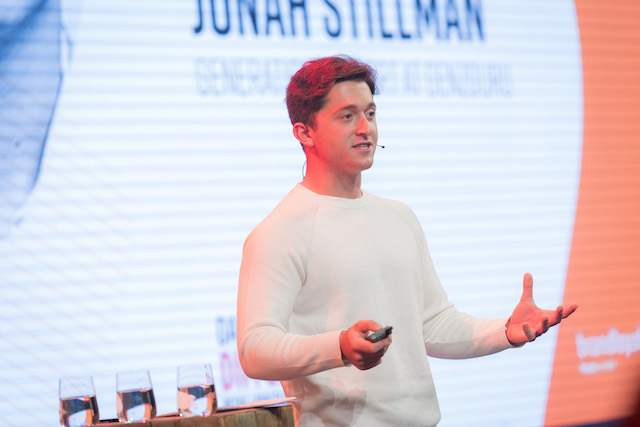Brands who want to engage with Generation Z need to “keep it real” says Gen Zer Jonah Stillman, who at just 20 has already built a career advising US corporations on strategies to break through to them.
“We have an intense vision and we expect brands to be ultra realistic with us with what they’re selling, how they’re selling it, and how they’re going to market towards us. Gen Z expects brands to be very real,” he told delegates to the BrandLoyalty Congress in Amsterdam.
“Most people tend to look at somebody under the age of 30 and assume we act the same, when in reality, my generation is very different to that. We come after the millennials. We were born between the years 1995 and 2012, which means the leading edge is already out of college, in the workplace and has a big spending power.”
Stillman, gave up a promising career in snowboarding (he was ranked fifth in the US before hanging up his board) and has since written his first book, just two years after graduating. He consults to the NFL and a raft of corporations about how to engage with Gen Z demographic and speaks all over the world.

By this year, 40 per cent of the globe’s consumers will be from Generation Z, he explains. “I’ve been sharing this stat for a long time now. And yet as we got closer and closer, people were still shocked to hear that there is a new generation entering as consumers.”
Keeping it real means dialling down the use of celebrities, he advises. Social-media influencers and content creators on YouTube or Instagram carry more weight
“If you’re trying to reach Gen Z, we have to see ourselves in your messaging. Gen Zers are saying they trust these creators much more than they would a big-time celebrity because we see much more of [an influencer’s] life and the content they create.”
The real world versus the virtual world
Stillman’s next tip is to embrace technology. “Gen Zers are not digital pioneers. We are truly digital natives. For my generation, the line between the physical and the digital worlds has not just been blurred, it’s been completely eliminated. My generation has grown up with constant connectivity. All I’ve ever had to do was look at my phone, my smartwatch or my tablet.
“For Gen Z, whether I physically put something in my cart at the store, or add it to my cart with a click of the button online, we do not differentiate between operating in the physical space versus a digital one.”
Many retailers mistakenly assume that because Gen Zers are always on their phones, they don’t want to shop in brick-and-mortar stores, only online.
“In reality, that’s not necessarily true. We know that 60 per cent of Gen Z shoppers prefer to make a purchase in a store. How do we know? Gen Z is hungry for authentic communication with the brand and we are looking for experiences. So create a reason for your Gen Z shopper to come into the store, whether that be a unique experience of limited time, in-person deal Gen Zers are hungry to shop offline.”
He says two thirds of Gen Zers want to make purchases directly from social media. And 91 per cent of Gen Z say a brand’s technological sophistication would impact their desire to shop with them.
‘We stand out, not fit in’
Stillman’s third tip is that Gen Z expects their shopping experience to feel customised. Unlike previous generations, Gen Zers have never strived to ‘fit in’.
“We want to do everything we can to stand out. And we’ve had the ability to do that by customising nearly every aspect of our life. A Gen Zer’s goal has never been to post the same thing as someone else on social media or wear the same pair of shoes – we want to find out how to be different.”
A classic example is the way Gen Zers listen to music. Where prior generations used to buy a CD in the hope of liking five of the 10 songs on it, Stillman’s generation never had that experience.
“We get to build our own playlists where we know we like all the songs. We’ve had the ability to customise so many aspects of our lives and we’ve also had experienced brands customising towards us. Our shopping experience has become much more personalised.
“For example, I log on to a site like Amazon or any other online shop, and it says ‘Welcome back Jonah – we saw that you bought a pair of shorts. Do you want a shirt to go with them?’ And I buy it and move on. We expect to have the ability to customise much of our products whether it be from having our name on a bottle to a customised message.
“When we walk in the door, we expect that brands are going to customise things for us. I worry that people will hear this and say ‘You’re self centred; it’s not all about you’. But the reality is, this is the world that we have grown up in.”
Stillman cites Nike ID, developed when research told the company that people would buy shoes more often if they could personalise them.
Communication with Gen Zers is a two-way, interactive process though. Seventy per cent of Gen Z shoppers say they have written reviews and nearly half say they write do so often. Even more notable: 44 per cent of Gen Zers are interested in submitting ideas for product design.
“This is very interesting to me because oftentimes we hear that brands want to wait to introduce something new until it is perfect. However, what we hear from Gen Z is they would rather be part of a brand’s discovery process. So let us be part of the early stages and give you feedback so that it feels as though our opinions and our values matter to your company. Don’t wait until it’s perfect to launch it – introduce a minimum viable product and let us have that dialogue with you.
Brands wanting to engage with Gen Zers should embrace Instagram, because that is where they hang out. “Instagram is where we will go to see what we call the highlight reel – the best of the best. We go there to see the highlight reel of companies, brands and our friends.”
Snapchat is for “life moments” and Twitter is the biggest news source for Gen Z. Last but not least, is Facebook, “where we expect to see the most advertisements”.
“Often, people will ask me, ‘If you see something that says hashtagged or sponsored do you skip right past it?’ The answer is no, because we expect that if a brand is going to pay money to put something in front of us, it is going to be relevant. It’s likely going to be a product that to some extent I want to see.”
Fear of missing out
Stillman’s final tip for retailers and brands was the concept ‘FoMo’ – the fear of missing out.
“We know that 65 per cent of Gen Zers sleep with their smartphones on or near their bed and we spend an average of four and a half days a week engaged on our smartphones.”
He says 79 per cent of Gen Z consumers display symptoms of “emotional distress” when kept away from their smartphones. “It creates diagnosed anxiety when we do not have access to the outside world, or to information, or both.
“Fun facts: one in 10 Gen Zers would rather go three days without refreshing their underwear than their Twitter feed. Forty per cent of Gen Zers says working WiFi is more important than a working bathroom.”
FoMo, he argues, creates a huge opportunity for marketers, because the sense extends into their general attitude to life, playing right into the rhythm of one of the oldest marketing tricks in the book: promoting that only a few items are left in stock
“They work with Gen Z because it triggers the anxiety that if we don’t interact now, we’re going to miss out on an opportunity. Some 79 per cent of Gen Zers said they make frequent impulse purchases.”
FoMo is a key reason marketers need to include a direct call to action in their messaging.
Whether this means buy now or miss out, it does absolutely trigger the ability for Gen Z to make a purchase.
This feature originally appeared in the Inside Retail Asia’s magazine edition, available by subscription in digital or print versions.






